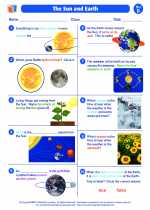The sun and earth -> grassland
Grassland Ecosystem
A grassland is a large open area of land covered with grasses, herbs, and a few scattered trees or shrubs. They are found on every continent except Antarctica. Grasslands are often referred to as prairies in North America, steppes in Eurasia, and savannas in Africa.
Characteristics of Grasslands:
- Climate: Grasslands are characterized by a semi-arid to semi-humid climate with hot summers and cold winters, and a moderate amount of precipitation.
- Vegetation: Grasses are the dominant vegetation in grasslands, with a variety of species adapted to the dry and windy conditions.
- Wildlife: Grasslands support a diverse range of wildlife including grazing animals like bison, antelope, and zebras, as well as predators like lions and wolves.
- Importance: Grasslands are important for agriculture, providing grazing land for livestock and fertile soil for farming.
Types of Grasslands:
There are two main types of grasslands:
- Temperate Grasslands: Found in the middle latitudes, these grasslands have cold winters and hot summers. They are often used for agriculture and are known for their rich soils.
- Tropical Grasslands: Found near the equator, these grasslands have warm temperatures year-round and distinct wet and dry seasons. They are home to a wide variety of wildlife.
Study Guide:
To study the topic of grasslands, consider the following questions:
- What are the main characteristics of grasslands?
- How do grasslands differ from other ecosystems like forests and deserts?
- What types of wildlife are commonly found in grasslands?
- Why are grasslands important for both wildlife and human activities?
- Compare and contrast temperate and tropical grasslands.
Understanding the ecosystem of grasslands is important for understanding the Earth's diverse environments and the relationships between plants, animals, and humans.
[Grassland] Related Worksheets and Study Guides:
.◂Science Worksheets and Study Guides Second Grade. The sun and earth
Study Guide The sun and earth
The sun and earth  Activity Lesson
Activity Lesson The Sun & Earth
The Sun & Earth  Worksheet/Answer key
Worksheet/Answer key The sun and earth
The sun and earth  Worksheet/Answer key
Worksheet/Answer key The sun and earth
The sun and earth  Worksheet/Answer key
Worksheet/Answer key The sun and earth
The sun and earth  Worksheet/Answer key
Worksheet/Answer key The Sun and Earth
The Sun and Earth  Vocabulary/Answer key
Vocabulary/Answer key The sun and earth
The sun and earth 

 Activity Lesson
Activity Lesson
 Worksheet/Answer key
Worksheet/Answer key
 Worksheet/Answer key
Worksheet/Answer key
 Worksheet/Answer key
Worksheet/Answer key
 Worksheet/Answer key
Worksheet/Answer key
 Vocabulary/Answer key
Vocabulary/Answer key

The resources above cover the following skills:
Concepts of Earth Science: A student should understand and be able to apply the concepts, processes, theories, models, evidence, and systems of earth and space sciences. A student who meets the content standard should:
Develop an understanding of the cyclical changes controlled by energy from the sun and by Earth's position and motion in our solar system.